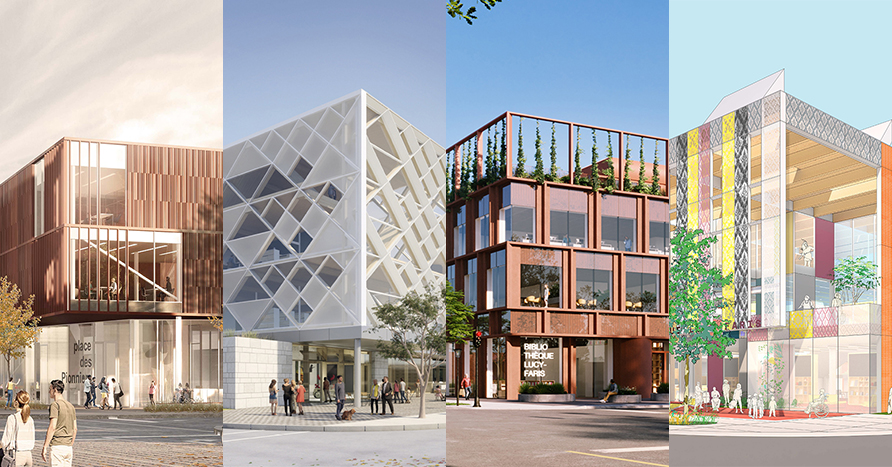The aim of the project is to provide the City of Gatineau with a signature building in the heart of Gatineau's Old Aylmer.
The symbolic force of the project and its public nature of welcome and accessibility to citizens call for a key meeting place at the heart of the daily use of Old Aylmer. Its location and deployment potential make it one of City of Gatineau's large-scale projects.
By enriching this strategic site of daily use, the project calls for a harmonious and radiant intervention, emanating in a way from a heritage context, as an articulation of the city in the Old Aylmer sector.
The image of identity and culture that the project will convey to the population will have to mark out the path of the citizens and establish itself as a tool for the development of this community.
Key statements expressing the City of Gatineau's order
- A three-storey building, two of which will house the library;
- A gross floor area of ± 5,500 m²;
- Underground parking
- A signature building that enhances the appeal and dynamism of Old Aylmer;
- A building that meets LEED v4 silver criteria;
- Synergy and complementarity between the various residential, commercial and recreational functions in the area.
(From competition program)
(Unofficial automated translation)
The jury meets behind closed doors for deliberations. It discusses the relevance of the entries to the project's objectives, and the evaluation criteria are as follows:
BEAUTY
Innovative character
Quality of the conceptual approach, ingenuity and clarity of the architectural approach; potential to arouse interest and encourage support; exemplarity for other comparable projects.
Form and materials
Plasticity and durability.
Landscape and environment
Integration with the environment, landscape and heritage.
Social and urban integration
Ambiance generated by the building and the evolving qualities of the site, neighborhood and environment; coherence of the new whole resulting from the addition of the project.
UTILITY
Use
Functional efficiency; versatility, ease of operation and evolutionary potential of spaces; achievement of program objectives through proposed spatial organization.
Accessibility
Organizational efficiency, readability of functional components and universal accessibility.
Spatiality
Sturdiness of spaces, enabling interior layouts to evolve over time. Perception of interior and exterior spaces.
Site experience
Richness, variety and quality of user experiences. Day-to-day quality of the work environment offered to employees, user-friendliness and ease of appropriation.
SOLIDITY
Technical performance of the building
Feasibility and likelihood of fully meeting the project's constraints with respect to the allocated construction budget and in consideration of the technical committee's conclusions.
Mastery and proper interpretation of program constraints and requirements
Sustainable development
Relevance and effectiveness of means deployed to preserve resources and ensure the health of ecosystems and occupants, overall performance in the short, medium and long term.
Engineering system
System performance and integration
Construction efficiency
Apparent control of investment and overall costs, simplicity of construction, efficient planning of construction phases, cost and ease of maintenance.
Technical quality and constructability of the work
Interest of the proposed solutions in relation to the effort required to realize them (construction) and to operate them (e.g. management, maintenance).
(From competition brief)
(Consult the competitors' projects for specific comments from the jury)
(Unofficial automated translation)
| Jury president |
Emmanuelle Lapointe, Architecte
|
| Jury | François Arsenault, Citoyen |
| | Pierre Corriveau, Architecte |
| | Yvon Dallaire, Architecte |
| | Claude Fugère, Architecte |
| | Noëlle Gratton-Tétreault, Bibliothécaire |
| | Michel Hudon, Ingénieur |
| |
|
| |
|
| |
|
| Technical Commitee | Martin Beaulieu |
| | Jasmine Bouchard |
| | Pierre-Luc Caron |
| | Yvon Chabot |
| | Sébastien Landry |
| | Louis Tardif |
Stage 1: Applications
Publication of notice of competition, documents available online: December 1, 2020
Site visit / information meeting: Not applicable
End of question period: January 19, 2021, 4:00 pm
End of period for answering questions: January 26, 2021, 4:00 pm
Submission of applications: February 9, 2021, 4:00 pm
First jury meeting/selection of finalists: February 15 and 16, 2021
Jury decision forwarded to promoter: February 19, 2021
Announcement of finalists and list of applications received: February 23, 2021
Stage 2: Submissions
Site visit / program presentation: March 2, 2021, 11:00 am
End of Q&A period: April 6, 2021 4:00 pm
End of Q&A period: April 13, 2021, 4:00 pm
Submission of submissions: April 27, 2021, 4:00 pm
Analysis of submissions by technical committee: April 29 May 13, 2021
Hearing of finalists: May 17, 2021
Second jury session / selection of winner: May 18, 2021
Transmission of jury decision to promoter: May 21, 2021
Announcement of competition results: May 25, 2021
Jury report and evaluation report: June 4, 2021
Distribution of submissions : June, 2021
After competition
Anticipated start of winner's term of office: May 26, 2021
(From competition brief)
(Unofficial automated translation)
Le lauréat du concours d’architecture de l’édifice Place des Pionniers est dévoilé, Portail Constructo, 2021
Nouvel édifice Place des Pionniers | Gatineau annonce le lauréat du concours d’architecture!, Kollectif, 2021
Gatineau dévoile le gagnant du concours d'architecture de la Place des Pionniers, Radio-Canada, 2021
Coderre, Julien, Concours pluridisciplinaire de la Place des Pionniers: les finalistes dévoilés, Ledroit, 2021
Place des Pionniers : place aux finalistes du concours d’architecture, Voir vert - Le portail du bâtiment durable au Québec, 2021
- Programme
- Règlement
- Rapport du jury (global)
